Yoga for New Surfers: Why and How the Board and Mat Must Meet
Want to learn how to surf? Try yoga first.
“If waves are the practice of water, and thoughts the practice of mind, wouldn’t it be wonderful if we all learned to surf?”
Jaimal Yogis
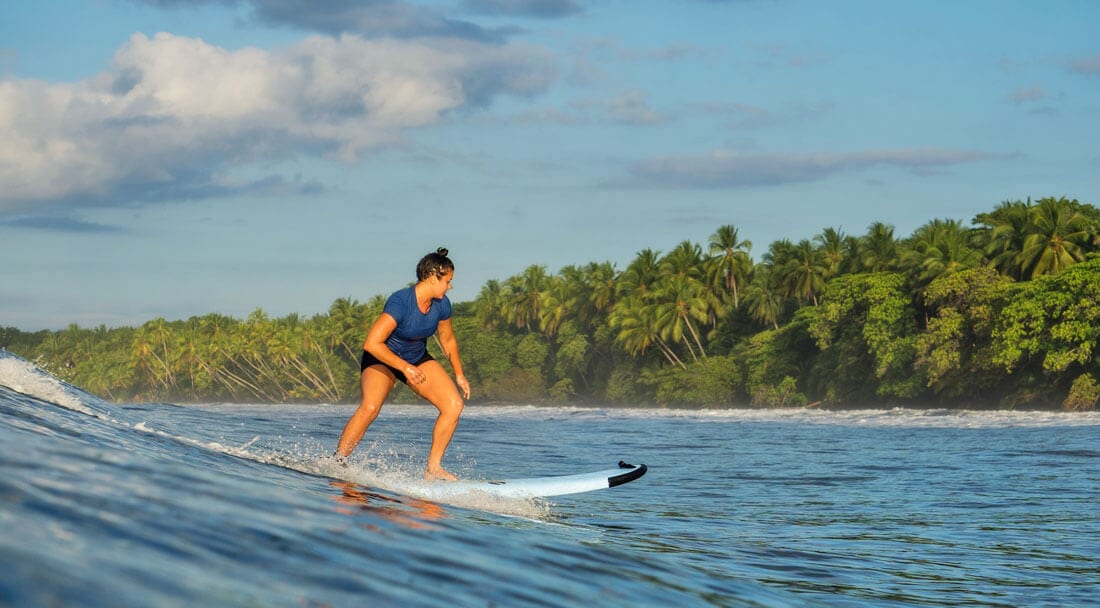
Yoga is a highly transferable practice that has a myriad of physical benefits that will undoubtedly help you learn how to surf — improved balance, strength, flexibility, and range of motion to name a few.
However, the original utility of the yoga Asanas, (Sanskrit for “poses”, and translating broadly to the entire physical practice of yoga), was to prepare the body for meditation. The ancient yogis recognized this a way to cultivate mental clarity and presence of mind.
And although the physicality of yoga has attracted an astonishing number of practitioners (300 million worldwide) looking to upgrade their fitness, the true value of adding a yoga regimen to your life lies with the mental gains.
The benefits of yoga for new surfers: why hit the mat before the waves
For those of you wondering, is yoga good for surfing? Well, yoga can benefit nearly any sport or physical pursuit for the following reasons:
- Strength
- Flexibility
- Coordination
- Mobility
- Balance
Yet it is some of the more subtle reasons that make why yoga so beneficila for surfing (and why it is such a critical component of our surf and yoga camp curriculum:
- Breathing
- Mental gains
Let’s dive a bit deeper to explain a bit more about how yoga is so complementary to the learn-to-surf process.
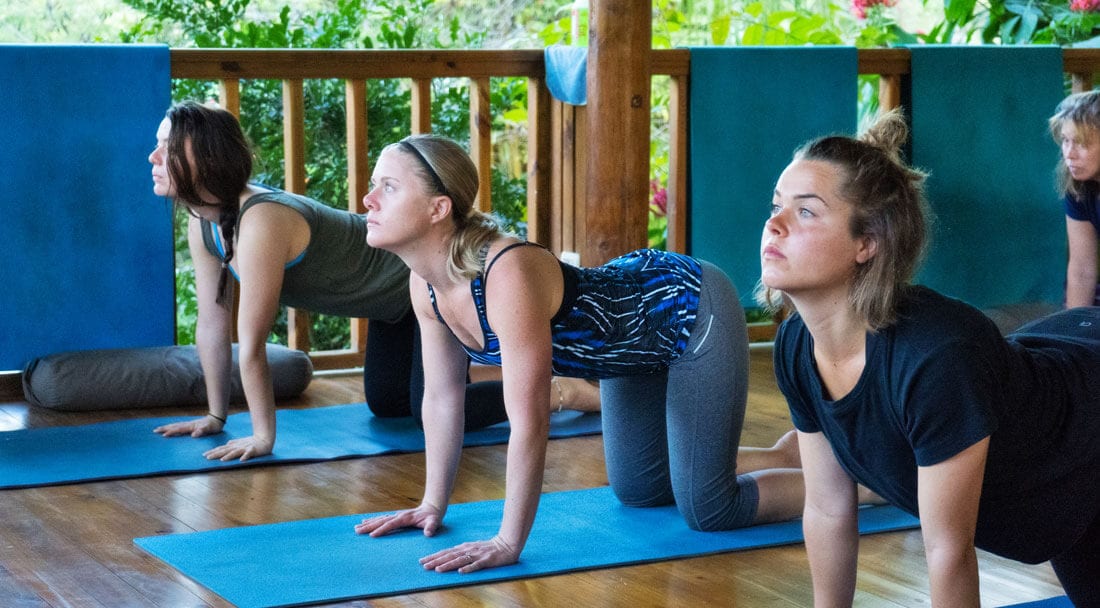
Mindfulness, aka mental gains
So how does mindfulness contribute to learning how to surf? Many reasons, but the main one is that the physical act of riding a wave requires zen-like focus.
Being able to immerse yourself in the moment, fully and profoundly, is your only option if you want to be successful.
Unlike almost every other sport, surfing takes place on an ever-changing playing field. This makes moment-to-moment awareness a key aspect of the activity.
“The intense focus surfing requires is so similar to the intense focus of deep meditation or ecstatic prayer or ritual dance or any number of so-called spiritual experiences, that it’s a pretty good bet that very similar things are going on in the brain.”
Dr. Andrew Newberg, neuroscientist
Surfing requires an extreme amount of patience; a surfer spends very little time actually standing up on his or her surfboard during a typical outing.
An average two-hour surf session may only yield a few minutes of actual standing/riding time. In fact, surfers spend the majority of each surf session either paddling out through the impact zone or sitting on their board waiting to catch a wave.
It is imperative to be able to maintain one’s composure while waiting for the reward.
Mastering the breath
A yoga practice cultivates mindfulness by centering the breath. This is something that many people in today’s over-anxious Western society have forgotten how to do, at least consciously.
When it comes to surfing, utilizing your breath properly will undoubtedly benefit you when you are out in the ocean, as you will be able to calm yourself down in what may otherwise be considered an anxiety-provoking situation.
The ocean may seem chaotic and scary at the surface, but once you dive beneath the waves, you learn that the ocean is quiet and calm at its depths.
The mind functions in a similar way — incessant thoughts at the surface; tranquility at the core. If you truly know how to breathe, not just autonomically but somatically, you will be able to mitigate the internal chatter and access that calm, quiet center with more ease and regularity.
In addition, surfing (like most sports) is an aerobic activity — consider the sprint of paddling as hard as you can to catch a wave. Yoga, and specifically the art of mastering the breath, is beneficial to any sport. Surfing in particular, as it is performed outside the terrestrial dwelling-place in which humans are more comfortable.
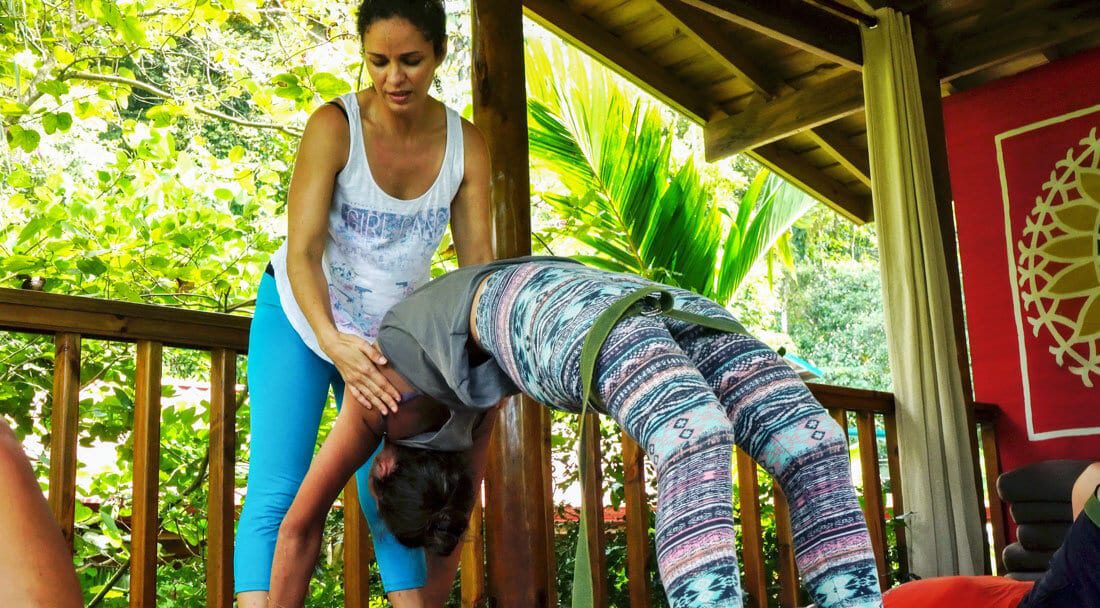
Engaging the core: Mobilize your spine
Practicing yoga is a great way to promote spinal health, as it recruits muscle strength and improves your posture. Both of these will benefit your surfing and allow you to stay out in the lineup for longer stretches of time. Surfing can be particularly stressful on your spine — the upward arch of the spine for extended periods, awkward falls, etc.
When paddling out to or around in the lineup on a surfboard, your spine will be extended. It would be helpful to prepare your body to maintain this position by warming up with a quick pre-surf yoga flow.
As previously mentioned in our guide for generating a surf report, it is best to observe ocean conditions for 15 minutes before entering the water to surf. You might as well take advantage of this time to limber up with some downward-facing dogs, cat-cows, and cobras!
How to get started: Four essential yoga poses for beginner surfers
When it comes time to enter the ocean for your first surf lesson, it will be very helpful to be familiar with some basic yoga poses. This will train your muscle memory and help you with the learn-to-surf process.
These Asanas can be practiced in a sequence, but are beneficial to your body as stand-alone poses as well. They can be done before or after surfing rightˆ on the beach.
Not only will they improve your body awareness, but they are also integral to the beginner surf curriculum here at Bodhi Surf + Yoga camp.
Here are recommendation of four great yoga postures that are ideal for beginner surfers.

1. Cobra Pose (Bhujangasana)
This particular Asana is a great way to stretch out the muscles of your chest, shoulders, and abdominals. It will warm up the body and and train your muscle memory for
Of note: you will also use this pose to keep the nose of your surfboard from diving underwater when catching a wave in the prone position, and also to get through smaller waves when you are “paddling out.”
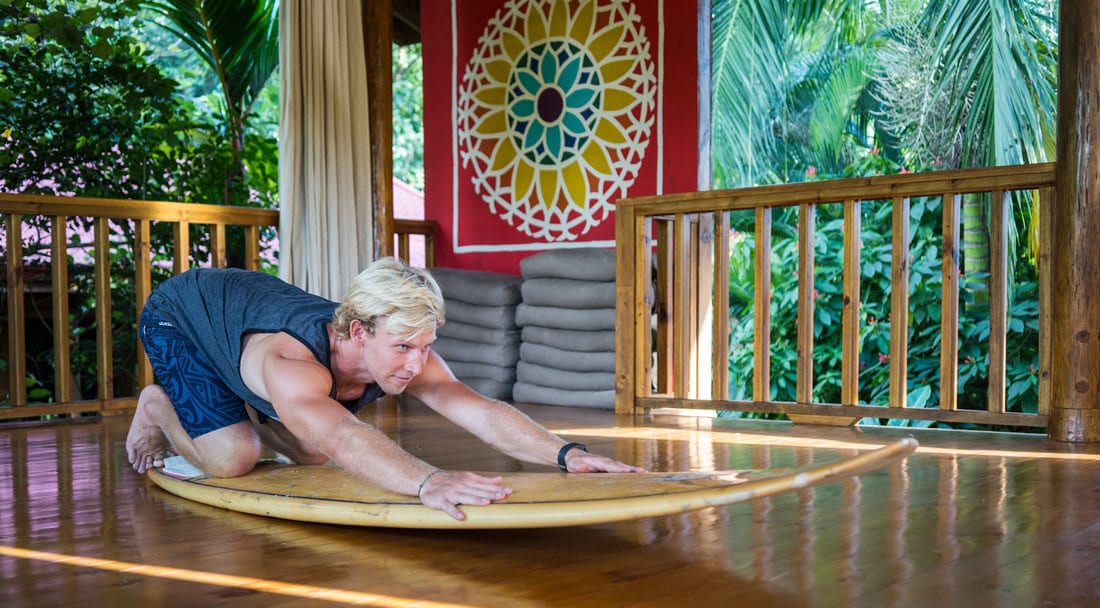
2. Child’s Pose (Balasana)
This relaxing position is a great way to open up your posterior chain and get a deep stretch in your hips, quads, and ankles.
It is also a great counter pose to the perpetual back bend that you are in when laying on your surfboard and paddling. It is an exceptional way to mitigate the lower back pain surfers often experience!
Of note: after successfully riding a wave to the beach in the prone position, you can use child’s pose to bring all of your weight to the back of your surfboard and come to a controlled stop.

3. Plank (Kumbhakasana)
Less of a stretch and more of a muscle-builder, plank pose will improve your core strength and recruit more muscle mass to your arms and shoulders.
This is an imperative motion to master on land, as it is used extensively in surfing.
Of note: You will have to use plank pose while paddling your surfboard through oncoming whitewater waves in order to make it out to the lineup. Furthermore, being able to push up into a plank will undoubtedly improve your ability to “pop-up” when standing to your feet on a surfboard.
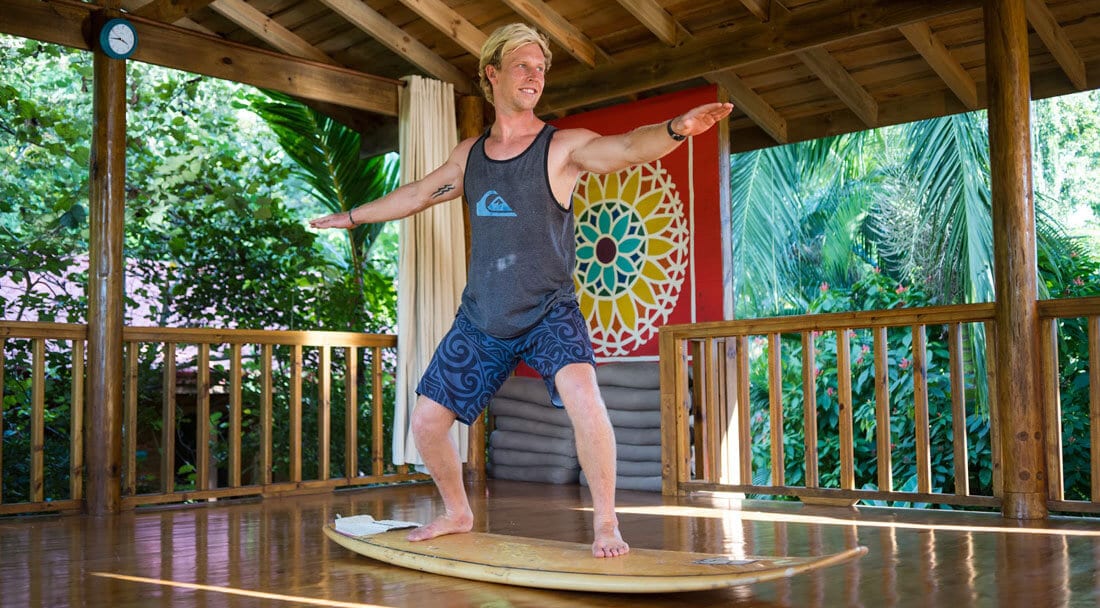
4. Warrior II (Virabhadrasana II)
This deep hip and groin opener is a great complement to surfing as sitting and standing on a surfboard can lead to tension in those areas.
It is also a great Asana to master on your path to improving your balance on a surfboard.
Of note: although Warrior II is not exactly the same stance you will maintain while surfing, it is very similar, and can help you get accustomed to standing in that position.
Pre-trip yoga flow: Practice at home
Need ideas for a daily yoga sequence? Want a feel for what a yoga class looks like at our camp?
Check out this 20-minute stretch sequence with Bodhi Surf + Yoga’s yoga instructor, Pilar Salazar.
This is a “flow” that you can practice at home in preparation for learning to surf to improve your muscle memory and help speed up the learn to surf process.
Remember: we are a surf and yoga camp, so we specialize in sharing the benefits of yoga for surfers!
Get a Toolkit to Create Calm in Your Inbox
Watch the first lesson from our full immersive course: 8 Limbs of Ashtanga Yoga, FREE!
Change the heading on the Separator tab ->
Search
Get a Toolkit to Create Calm in Your Inbox
Watch the first lesson from our full immersive course: 8 Limbs of Ashtanga Yoga, FREE!
Change the heading on the Separator tab ->
Most Read Blogs
What is the Meaning of Anjali Mudra?
May 27, 2020
Fitness for Surfers: Workouts, Exercises & Training
February 10, 2022
The Best Places to Eat in Uvita, Costa Rica
May 19, 2022
How to Get From SJO to Costa Ballena, Costa Rica
May 31, 2018
Change the heading on the Separator tab ->
Categories
Categories
- Bodysurfing (5)
- Food (6)
- Responsible Business (6)
- Surfing (61)
- Travel (63)
- Yoga (39)
Change the heading on the Separator tab ->
Newsletter
Thanks for subscribing! Please check your email for further instructions.
Change the heading on the Separator tab ->
Follow Us
Bodhi Surf + Yoga
Change the heading on the Separator tab ->
Read more
A Typical Day: Bodhi Sessions 14 Day Surf + Yoga Camp
Words by George Frost
If you’re looking for a surfing and yoga experience that inspires, educates, and empowers – look no further! Our Bodhi Sessions 14 Day Surf + Yoga Camp is designed to help you…
A Typical Day: Bodhi Slide 7 Day Bodysurf + Yoga Camp
Words by George Frost
We’re stoked that you’re interested in learning how to bodysurf – it really is a one-of-a-kind activity that allows us to connect deeply with the ocean and Mother Nature. If you’ve already…
A Typical Day: Bodhi Family Surf Camp
Words by George Frost
If you’re looking for a truly special bonding and connecting experience for your family, our Bodhi Family Surf Camp is the perfect vacation package for you! We’ll be using this blog to…



